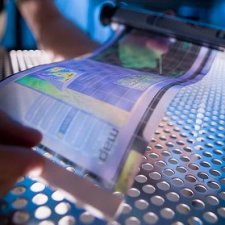Researchers at the Tel Aviv University have developed a novel DNA-peptide structure that could be used for production of thin, transparent, and flexible digital displays.

Prof. Ehud Gazit of the Department of Molecular Microbiology and Biotechnology at TAU's George S. Wise Faculty of Life Sciences, along with Or Berger, a doctoral student, had collaborated with Dr. Yuval Ebenstein and Prof. Fernando Patolsky from the School of Chemistry at TAU's Faculty of Exact Sciences in this study.
Electronic displays are used in a wide range of devices including interactive TV screens, computer monitors, tablets and smartphones.
Portable devices that are more convenient are desired as the necessity for instant communication increases.
It would be very comfortable if devices such as computer displays could be rolled for storage. Present day displays require a flat surface to be stored and also when transported.
Our material is light, organic, and environmentally friendly. It is flexible, and a single layer emits the same range of light that requires several layers today. By using only one layer, you can minimize production costs dramatically, which will lead to lower prices for consumers as well.
Prof. Ehud Gazit of the Department of Molecular Microbiology and Biotechnology at TAU
This study was a part of Berger's Ph.D. thesis. Various peptide combinations were tested as part of the study. These peptides were short protein fragments that had DNA elements embedded within them. These DNA elements enabled a unique molecular architecture to be self-assembled.
DNA and peptides are considered to be among the most basic building blocks of life. These building blocks make up every cell in all types of life forms and are used by scientists to develop innovative technologies in bionanotechnology. These building blocks deliver properties that plastic, metal and other inorganic materials do not have.
Our lab has been working on peptide nanotechnology for over a decade, but DNA nanotechnology is a distinct and fascinating field as well. When I started my doctoral studies, I wanted to try and converge the two approaches. In this study, we focused on PNA — peptide nucleic acid, a synthetic hybrid molecule of peptides and DNA. We designed and synthesized different PNA sequences, and tried to build nano-metric architectures with them.
Or Berger
The researchers utilized electron microscopy and X-ray crystallography in their study. They had synthesized molecules, and among them they found that three could self-assemble within a couple of minutes into ordered structures. These structures not only exhibited the characteristics of peptides but also had a resemblance to DNA’s natural double-helix form. The novel material possessed a duality which led to the distinct molecular arrangement.
Once we discovered the DNA-like organization, we tested the ability of the structures to bind to DNA-specific fluorescent dyes. To our surprise, the control sample, with no added dye, emitted the same fluorescence as the variable. This proved that the organic structure is itself naturally fluorescent.
Or Berger
These structures had the ability to emit light in all colors. Other fluorescent materials have the capability to shine in a particular color. The researchers also observed that application of electric voltage led to light emission. This property would make it suitable for display screens and other such opto-electronic devices.
TAU's technology transfer company, the Momentum Fund of Ramot had provided funds for this study. It has also patented this innovative technology. A prototype of the screen is presently being built by the research team. Furthermore, they are in discussions regarding this technology with large consumer electronics companies.
This study has been published in the journal, Nature Nanotechnology.
References